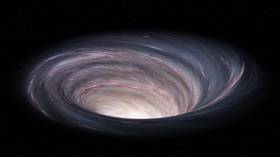Black holes can grow ‘hair’ when spinning fast enough in dramatic extension of Einstein’s theory of gravity

An international team of scientists has found that black holes can grow "hair" if they spin fast enough, providing fresh insights at the fringe of our understanding of the universe.
In a new study, researchers used numerical simulations which indicated that black holes can spontaneously erupt what has been described as a hair (otherwise known as an additional scalar field), once they reach a certain spin speed.
This new insight into the behavior of fast-spinning black holes or neutron stars would come as an extension to Einstein’s theory of gravity.
“While previous studies have already provided examples of 'hairy' black hole solutions, we have shown for the first time, thanks to numerical simulations, that black holes can spontaneously grow the simplest form of permanent hair (a scalar field) once they start spinning fast enough,” says Alexandru Dima, astrophysicist at SISSA and INFN and first author of the paper.
Also on rt.com Mysterious, unexplained GHOST CIRCLES hovering in space leave astronomers baffledEinstein's theory of gravity and the associated mathematical theorems based on it indicate that black holes can grow 'hair' but it is eventually shed thanks to gravitational waves.
According to this latest research, however, once black holes reach a certain spin speed, the hair can hang around for longer thanks to “tachyonic instability.” Additional study and calculations are required to definitively prove the findings, especially as the research is at the very frontier of gravitational research.
However, these types of discoveries help further humanity’s understanding of the “dark side” of the universe, including, but not limited to, dark energy and dark matter.
In addition, further discoveries and experiments could “possibly discover novel hints of new physics beyond General Relativity,” Dimu concludes.
“Our results demonstrate that new physics can be quite elusive and only make an appearance when one looks carefully at the right type of black holes.”
Also on rt.com Earth 2,000 light years CLOSER to supermassive black hole & moving FASTER than previously thought – astronomersLike this story? Share it with a friend!















